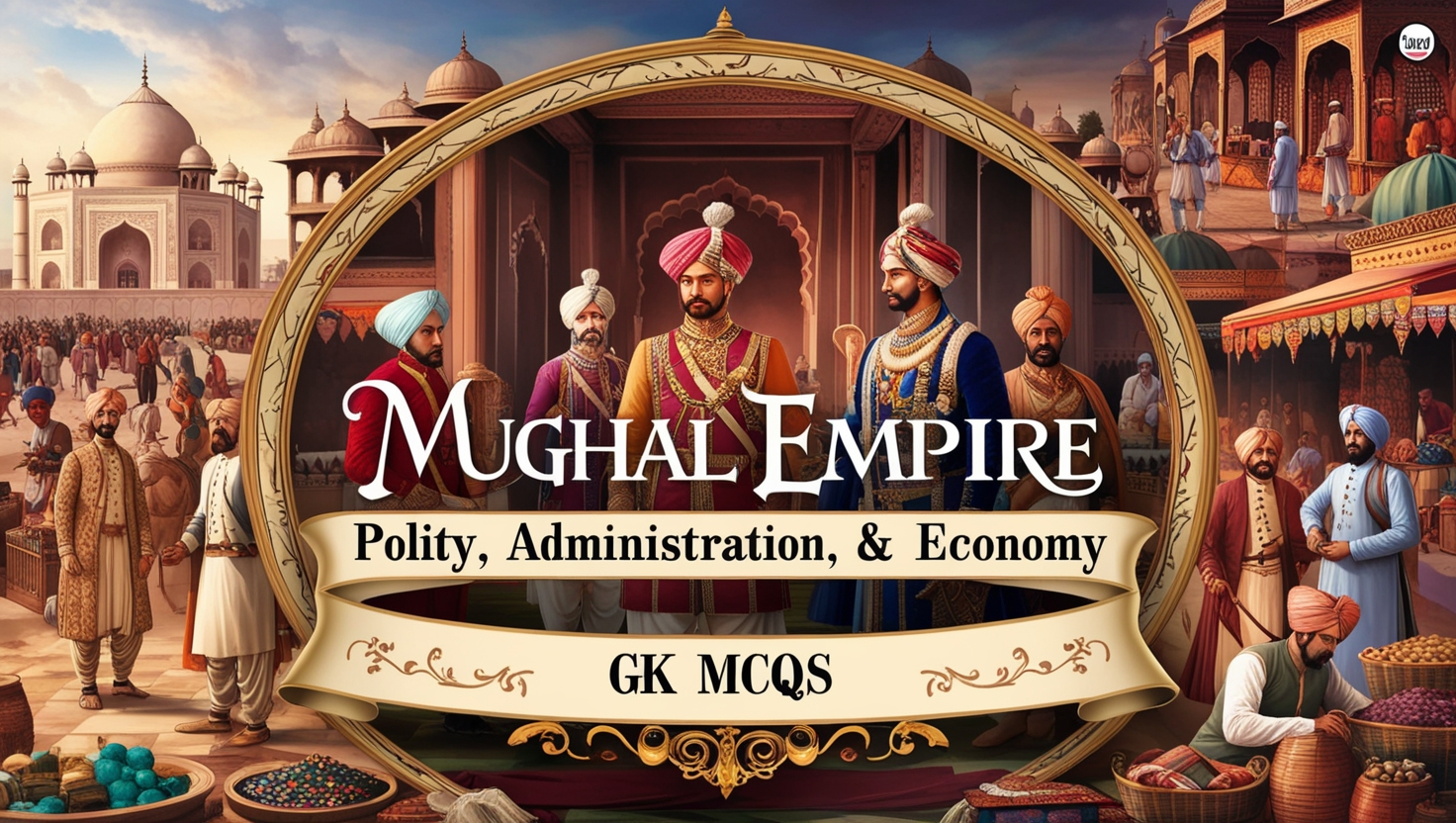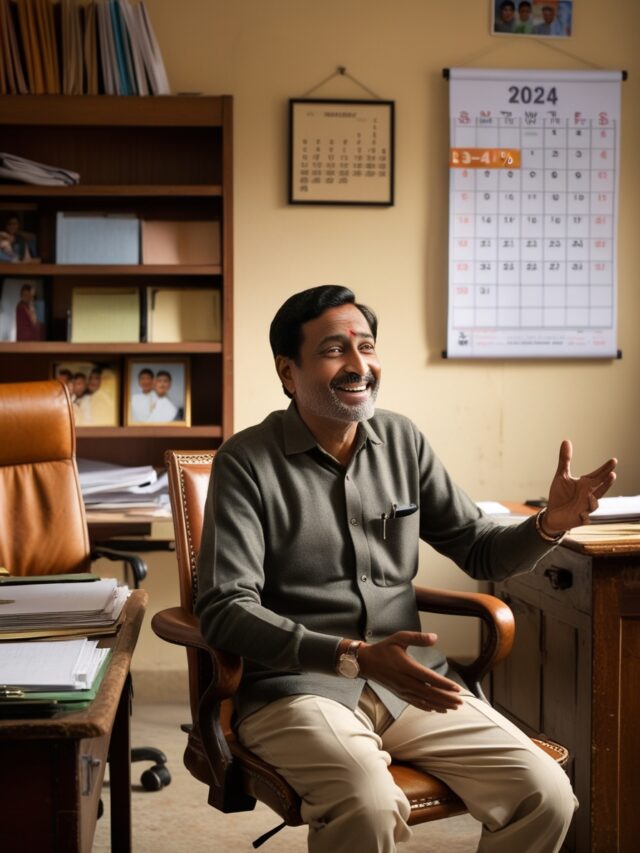
1. Who was the superintendent of ports under the Mughals?
- Mutsaddi
- Mir-i-Bahar
- Tahvildar
- Mushrif
Show Answer
Answer: Mir-i-Bahar
The Mir-i-Bahar held a vital role during the Mughal period as the official in charge of customs, boats, ferry taxes, and port duties in coastal towns. Their responsibilities included managing the collection of customs duties at ports, overseeing the usage of boats and ferries, and ensuring the levying of appropriate taxes. This position was crucial in maintaining maritime trade and revenue collection along India’s extensive coastline.
2. What is the correct meaning of the office of Qazi-ul-Quzat under the Mughals?
- Head of the Finance department
- Censor of Public morals
- Supreme Authority in Justice
- Incharge of charities
Show Answer
Answer: Supreme Authority in Justice
The Qazi-ul-Quzat, often referred to as the Qazi, was the chief judge of the Mughal empire and held the highest authority in matters of justice. Their primary role was to administer justice in accordance with Islamic law (Sharia) on behalf of the emperor. The Qazi-ul-Quzat played a central role in ensuring the implementation of legal and judicial proceedings according to Islamic jurisprudence, contributing to the administration of justice within the empire.
3. During the Delhi Sultanate, who were called the Barids?
- Craftsmen
- Bodyguards of the Sultan
- Officer-in-charge of state exchequer
- The spy / news reporters
Show Answer
Answer: The spy / news reporters
The Barid-i-mumalik served as the head of the information and intelligence department during the Delhi Sultanate. Their responsibilities included the gathering, reporting, and management of critical information to the Sultan. This role was instrumental in ensuring that the Sultan remained well-informed about developments within the empire and beyond, serving as a vital source of intelligence.
4. The Mansabdari system was borrowed from which region?
- Afghanistan
- Turkey
- Mongolia
- Persia
Show Answer
Answer: Mongolia
The Mansabdari system, introduced by Akbar, was indeed inspired by systems followed in Central Asia, particularly Mongolia. This system ranked officials within the Mughal administration based on their combined military and administrative capabilities. Each officer, known as a mansabdar, held a specific rank and was assigned both military responsibilities and administrative roles, reflecting the integrated nature of governance and military service in the Mughal empire.
5. Who among the following was appointed as the supreme authority in justice during the era of Mughal Emperors?
- Qazi-ul-Quzat
- Qazi-ul-Hazat
- Qazi-Faiz-ul-Islam
- None of these
Show Answer
Answer: Qazi-ul-Quzat
The Qazi-ul-Quzat, as previously explained, was the supreme authority in justice during the Mughal period. They held the paramount position in administering justice according to Muslim law, thus ensuring the equitable resolution of legal matters on behalf of the emperor.
6.Who introduced the Zabti system and Dahshala system?
- Raja Todar Mal
- Firuz Shah Tughlaq
- Raja Man Singh I
- Ibrahim Lodi
Show Answer
Answer: Raja Todar Mal
Raja Todar Mal, who served as the finance minister during Akbar’s reign, introduced two crucial revenue reforms: the Zabti system and the Dahshala system. These measures aimed to streamline revenue collection, improve assessment, and increase the efficiency of the imperial treasury. The Zabti system, in particular, involved a fixed assessment of land revenue, contributing to more consistent tax collection.
7. “Muazzama” was the title of which of the following Mughal Emperors?
- Shah Alam II
- Mohammad Shah
- Bahadur Shah Zafar
- Jahandar Shah
Show Answer
Answer: Bahadur Shah Zafar
Bahadur Shah Zafar, also known as Bahadur Shah I, assumed the throne of the Mughal empire in 1707 and ruled until 1712. His reign marked the last significant period of Mughal rule. Despite the empire’s waning power, his reign is known as the “Mughal Muazzama,” reflecting the continuance of the Mughal dynasty’s presence and significance during his rule.
8. In which year did Akbar centralize the control and functioning of various mints?
- 1570
- 1572
- 1576
- 1578
Show Answer
Answer: 1570
Akbar centralized control over the various mints in the year 1570. Under his administration, coins were issued from these mints in three different metals: gold, silver, and copper. This centralized control over currency production allowed the Mughal empire to standardize its coinage and enhance economic stability.
9. Akbar had adopted the ‘Ray’ System of revenue assessment, which he later abolished. Who had introduced the ray system?
- Alauddin Khilji
- Balban
- Iltutmish
- Sher Shah Suri
Show Answer
Answer: Alauddin Khilji
The ‘Ray’ System of revenue assessment, introduced by Alauddin Khilji, was later modified and reformed by Akbar during his reign. This system involved a detailed assessment of land and revenue collection. Akbar refined the ‘Ray’ System to create a more efficient and standardized revenue collection process.
10. Which term precisely defines the loans given to cultivators for seeds, farm implements, etc., in the Sultanate and Mughal period?
- Dams
- Dahsala
- Taqqavi
- Nasaq
Show Answer
Answer: Taqqavi
The term “Taqqavi” refers to a loan given to individuals for agricultural rehabilitation and development. This system, initiated by the Tughlaqs during the Sultanate period, aimed to support agricultural growth and the recovery of the agricultural sector.
Q11: Faujdar and Amalguzar were the chief officials of the ‘Sarkars’ (administrative divisions) in the Mughal Period. Amalguzar was related to which of the following operations?
1. Law & Order
2. Revenue Collection
3. Defence
4. Audit and Accounts
Show Answer
Answer: 2
Explanation: The Amalguzar during Akbar’s reign played a significant role by exercising general supervision over all types of lands. This position involved ensuring adherence to imperial rules and regulations and overseeing the assessment and collection of land revenue uniformly across the empire. The Amalguzar was instrumental in implementing and maintaining uniform land revenue policies.
Q12: What was the main responsibility of Mir Bakshi during the Mughal Era?
1. All incomes and expenditures
2. Military department
3. Revenue department
4. Royal correspondence
Show Answer
Answer: 2
Explanation: Mir Bakshi, an integral figure in the Mughal administration, was responsible for overseeing the military pay and accounts office. As the imperial paymaster, Mir Bakshi managed the distribution of salaries and benefits to the Mansabdars and other military personnel within the Mughal army.
Q13: Raja Todar Mal introduced standard weights and measures, a land survey and settlement system, revenue districts, and officers during Akbar’s reign. In whose reign as a finance minister did Raja Todar Mal develop his expertise?
1. Humayun
2. Akbar
3. Sher Shah Suri
4. Babur
Show Answer
Answer: 3
Explanation: Raja Todar Mal’s expertise as a finance minister was honed during his service in the court of Sher Shah Suri, the founder of the Sur Empire. He later became one of Akbar’s Navaratnas, playing a crucial role in implementing significant revenue reforms and taxation systems during Akbar’s reign.
Q14: Which among the following was a unit of Mughal Empire for the purpose of Administration and Revenue Collection?
1. Paraganas
2. Subahs
3. Parautis
4. Grama
Show Answer
Answer: 2
Explanation: Subahs were administrative and revenue units within the Mughal Empire, headed by a Subahdar. These officials were responsible for revenue collection, administration, and military affairs within their respective regions. The subahs played a key role in the decentralized governance of the empire, ensuring the efficient management of provinces.
Q15: Akbar’s administrative system was inspired by the administrative system of which of the following rulers?
1. Harsha
2. Vikramaditya
3. Sher Shah Suri
4. None of the above
Show Answer
Answer: 3
Explanation: The administrative system during Akbar’s reign was characterized by centralization and drew inspiration from the administrative system of Sher Shah Suri. Akbar retained several features of the Sultanate and Sher Shah Suri’s administration, contributing to the efficiency and stability of the Mughal empire.
Q16: During the reign of Akbar, the territories of the empire were divided into which of the following categories?
1. Jagir, Mansab, Iqta
2. Jagir, Khalisa, Inam
3. Jagir, Khalisa, Mansab
4. Iqta, Khalisa, Jagir
Show Answer
Answer: 2
Explanation: During Akbar’s rule, the Mughal territories were categorized into three primary land divisions: Jagir (land assigned to nobles in exchange for services), Khalisa (land directly controlled by the emperor), and Inam (land granted as a reward or gift). This division of land played a crucial role in the empire’s governance and revenue collection.
Q17: Which of the following was the supreme head of the administration during the Mughal administration?
1. Council of ministers
2. Wazir
3. Emperor
4. None of the above
Show Answer
Answer: 3
Explanation: During the rule of the Mughal Empire, the Emperor was the supreme head of the administration and controlled all military and judicial powers. All officers in the Mughal administration owed their power and position to the Emperor.
Q18: Who acted as the principal link between the ruler and the administration during the Mughal administration?
1. Wazir
2. Mir Bakshi
3. Mir Saman
4. Council of Ministers
Show Answer
Answer: 1
Explanation: During the rule of the Mughal Empire, the position of the wazir was revived. The Wazir acted as the principal link between the ruler and the administration, and various heads of departments functioned under the control of the Wazir.
Q19: Who was the head of the revenue department during the Mughal administration?
1. The Emperor
2. Wakil
3. Wazir
4. Mir Bakshi
Show Answer
Answer: 3
Explanation: In the Mughal administration, the head of the revenue department held the title of Wazir, even though they were no longer the principal adviser to the ruler. The Wazir, well-versed in revenue affairs, also held the title of diwan or diwan-i-ala, signifying their expertise in revenue management.
Q20: Recommendations for appointment to mansabs or for promotions were made to the emperor after being duly endorsed by which of the following?
1. Wazir
2. Mir Bakshi
3. Mir Saman
4. Wakil
Show Answer
Answer: 2
Explanation: Recommendations for appointments to mansabs or for promotions were subject to the endorsement of Mir Bakshi before being presented to the emperor. Once accepted by the emperor, these recommendations were then confirmed by the diwan, and jagirs (land assignments) were assigned to the appointees, creating a systematic process for the appointment and promotion of officials.
Q21: Who was the head of the intelligence and information agencies of the Mughal empire?
1. Wazir
2. The Emperor
3. Wakil
4. Mir Bakshi
Show Answer
Answer: 4
Explanation: Mir Bakshi, who held the position of Mir Bakshi in the Mughal administration, was responsible for overseeing the military pay and accounts office. This role was of utmost importance, as it involved distributing salaries and benefits to Mansabdars and other military personnel within the Mughal army.
Q22: Who was the officer-in-charge of the royal household and royal karkhanas in the Mughal Empire?
1. Wazir
2. Mir Bakshi
3. Mir Saman
4. Wakil
Show Answer
Answer: 3
Explanation: Mir Saman, during the Mughal era, was in charge of the royal household and royal karkhanas. This role included supervising various court affairs, overseeing purchases, manufacturing of goods for the royal household, and maintaining decorum and etiquette at the Mughal court. Only nobles who enjoyed the complete confidence of the emperor were appointed to this office.
Q23: During the Mughal era, who had the duty of maintenance of etiquette at the court?
1. Wazir
2. Mir Bakshi
3. Mir Saman
4. Wakil
Show Answer
Answer: 3
Explanation: The responsibility of maintaining decorum and etiquette at the Mughal court during the Mughal era fell under the purview of Mir Saman. This officer-in-charge of the royal household and royal karkhanas ensured that proper etiquette and standards were upheld at the court, contributing to the refinement and elegance of the Mughal courtly environment.
Q24: Which of the following was the Qazi-ul-Quzat during Akbar’s reign?
1. Abdullah Sultanpuri
2. Abdun Nabi
3. Muhammad Fakhrul Islam
4. Abul Fazl
Show Answer
Answer: 2
Explanation: The judicial department was headed by the chief qazi or Qazi-ul-Quzat. The chief qazi during Akbar’s reign was Abdun Nabi, who was later accused of corruption.
Q25: Akbar divided the empire into how many circles for purposes of grant of inam lands?
1. 6
2. 5
3. 10
4. 16
Show Answer
Answer: 1
Explanation: During Akbar’s rule, he initiated a deliberate policy of separating inam lands from jagir and khalisa lands, dividing the empire into six circles for granting and administering inam lands. This policy aimed to encourage persons of different religious faiths and beliefs to cultivate land, promoting greater agricultural development and the extension of cultivation.
Q26: Who were appointed to ensure the general observance of the rules of morality during the rule of the Mughal Empire?
1. Mir Bakshi
2. Wakil
3. Muhtasibs
4. Wazir
Show Answer
Answer: 3
Explanation: Muhtasibs served as the censors of public morals during the Mughal Empire in India. Their role was to ensure the general observance of moral rules and ethical standards. Muhtasibs also inspected weights and measures, enforced fair pricing, and took measures to maintain public morality, contributing to a well-regulated and ethical society.
Q27: During the reign of Akbar, the Mughal empire was divided into how many Subas?
1. 10
2. 11
3. 12
4. 13
Show Answer
Answer: 3
Explanation: Under Akbar’s rule, the Mughal Empire was divided into twelve provinces or subas, including Allahabad, Agra, Awadh, Ajmer, Ahmedabad, Bihar, Bengal, Delhi, Kabul, Lahore, Malwa, and Multan. These provinces were governed by appointed Subedars (provincial governors) who were responsible for managing administration, revenue collection, and law and order within their respective territories.
Q28: Which of the following was not one of the provinces into which the Mughal empire was divided during the reign of Akbar?
1. Agra
2. Malwa
3. Kashmir
4. Lahore
Show Answer
Answer: 3
Explanation: It’s accurate that during Akbar’s rule, the Mughal Empire consisted of twelve provinces or subas, including Agra, Malwa, and Lahore. However, Kashmir was not one of the provinces during his reign.
Q29: Who was the head of a province during the Mughal Administration?
1. Wazir
2. Subedar
3. Faujdar
4. Muqaddam
Show Answer
Answer: 2
Explanation: Each suba (province) during the Mughal Empire was indeed placed under the governance of a Subedar (provincial governor) directly appointed by the Emperor. Subedars held authority over the administration, revenue collection, and law and order within their respective provinces, ensuring effective regional governance.
Q30: Who was responsible for the maintenance of general law and order in a province during the rule of the Mughal empire?
1. Subedar
2. Faujdar
3. Mir Bakshi
4. Shiqdar
Show Answer
Answer: 1
Explanation: During the rule of the Mughal Empire in India, each Suba (province) was placed under a Subedar (provincial governor) who was responsible for the maintenance of general law and order in the province.
Q31: Who was responsible for maintaining the communication channel during the Mughal Era?
1. Sadar
2. Merwars
3. Darogai-i-Dak
4. Bakshi
Show Answer
Answer: 3
Explanation: During the effective rule of the Mughals, particularly Akbar, many officers were appointed at the provincial level in the administration, and one of them was Darogai-i-Dak, who was responsible for maintaining the communication channel. He used to pass on letters to the court through the Merwars or postal runners.
Q32: Who was the chief revenue officer of a province under the Mughals?
1. Bakshi
2. Diwan
3. Sadar
4. None of the above
Show Answer
Answer: 2
Explanation: The chief revenue officer of a province in the Mughal administration was the Diwan. Appointed by the Emperor, the Diwan held an independent position responsible for overseeing revenue collection in the suba (province) and maintaining records of all expenditures.
Q33: Which of the following were the functions of Diwan in the administration of Akbar?
1. Diwan had to supervise the revenue collection in the suba and maintain accounts of all expenditures.
2. He was also expected to increase the area under cultivation.
3. Sometimes taccavi or advance loans were given to peasants through his office.
Select the correct option from the codes given below:
1. Only 1 & 2
2. Only 2 & 3
3. Only 1 & 3
4. 1, 2 & 3
Show Answer
Answer: 4
Explanation: The Diwan, during Akbar’s rule, played a multifaceted role in the administration. They supervised revenue collection in the suba (province) and maintained accounts of expenditures. Additionally, Diwans were tasked with increasing the area under cultivation and, at times, facilitating the disbursement of advance loans (taccavi) to peasants to support agricultural activities.
Q34: Who was the revenue collector during the Mughal rule?
1. Fauzdar
2. Zamindar
3. Amalgujar
4. Subedar
Show Answer
Answer: 3
Explanation: The revenue collector at the provincial level during the Mughal rule was referred to as the Amalguzar or Amil. Their responsibilities included assessing and supervising revenue collection within their assigned areas, as well as maintaining detailed financial records.
Q35: During the Mughal era, who had the duty to maintain all accounts and send the daily receipt and expenditure report to the provincial Diwan?
1. Faujdar
2. Amalguzar
3. Shiqdar
4. Muqaddam
Show Answer
Answer: 2
Explanation: The Amalguzar or Amil was a pivotal figure responsible for maintaining accounts and sending daily reports on revenue receipts and expenditures to the provincial Diwan. Additionally, they played a crucial role in overseeing and managing the process of revenue collection within their designated areas.
Q36: At the level of Pargana, who was the executive officer in Mughal Administration?
1. Shiqdar
2. Kotwals
3. Muqaddam
4. Patwari
Show Answer
Answer: 1
Explanation: At the level of Pargana, which was an administrative division during Akbar’s reign, the Shiqdar served as the executive officer. Their primary role was to assist the Amil in the task of revenue collection, contributing to the efficient collection of revenue within the region.
Q37: Which of the following kept all the records of land in the Pargana?
1. Shiqdar
2. Quanungo
3. Kotwals
4. Muqaddam
Show Answer
Answer: 2
Explanation: The Shiqdar was indeed the executive officer at the Pargana level, supporting the Amil in the process of revenue collection. Additionally, the Quanungo played a role in maintaining land records and administrative documentation in the Pargana.
Q38: Which of the following were appointed mainly in towns by the imperial government and were in charge of law and order?
1. Shiqdar
2. Kotwals
3. Amil
4. Quanungo
Show Answer
Answer: 2
Explanation: The Kotwals were appointed mainly in towns by the imperial government and were in charge of law and order. They maintained order in urban areas, while the Amil assisted the Shiqdar in revenue collection.
Q39: Who was the village headman during the Mughal era?
1. Muqaddam
2. Patwari
3. Qiladar
4. Mutasaddi
Show Answer
Answer: 1
Explanation: In the Mughal era, the village headman was referred to as the Muqaddam, and the Patwari was responsible for maintaining village revenue records. Additionally, Zamindars, who were landowners, played a role in maintaining law and order in their respective areas and participated in the collection of revenue.
Q40: The forts were placed under which of the following during Mughal rule?
1. Sipahasalar
2. Qiladar
3. Mutasaddi
4. None of them
Show Answer
Answer: 2
Explanation: Forts within the Mughal administration were overseen by an officer known as the Qiladar. The Qiladar held responsibility for the general administration of the fort and the areas assigned to them as jagir, contributing to the protection and maintenance of fortifications.
Q41: What was the land revenue at the time of Akbar?
1. 1/2 of the average produce
2. 1/3 of the average produce
3. 1/4 of the average produce
4. 1/5 of the average produce
Show Answer
Answer: 2
Explanation: Under Akbar’s rule, the land revenue amounted to one-third of the average produce and was primarily paid in cash. Akbar introduced the Zabti or Bandobast system, which aimed to standardize and improve revenue collection. This system was further refined by Raja Todar Mal, the finance minister.
Q42: Which of the following introduced the Dahsala System?
1. Akbar
2. Humayun
3. Jahangir
4. Shahjahan
Show Answer
Answer: 1
Explanation: Around 1580 CE, Akbar introduced the Dahsala System as a revenue collection method. Under this system, revenue was assessed based on the average yield of land over the previous ten years, contributing to a more stable and predictable revenue collection process.
Q43: Which of the following describes the batais or ghallabakhshi?
1. Produce was divided between the peasants and the state in a fixed proportion.
2. Rough appraisement based on the inspection of the crops and past payments made by the village as a whole.
3. . Produce was divided between the ministers and the state in a fixed proportion.
4. None of the above.
Show Answer
Answer: 1
Explanation: Akbar followed a number of assessment systems, and the most common one was the batais or ghallabakhshi, where the produce was divided between the peasants and the state in a fixed proportion.
Q44: What is the nasaq or kankut system?
1. System in which revenue was fixed on the average yield of land assessed on the basis of the past ten years.
2. System in which produce was divided between the peasants and the state in a fixed proportion.
3. System in which rough appraisement based on the inspection of the crops and past payments made by the village as a whole.
4. None of the above.
Show Answer
Answer: 3
Explanation: In the nasaq or kankut system, there was a rough appraisement based on the inspection of the crops and past payments made by the village as a whole. In contrast, in the batais or ghallabakhshi system, the produce was divided between the peasants and the state in a fixed proportion.
Q45: During Akbar’s rule, what was chachar land?
1. Never cultivated
2. Cultivated once a year
3. Cultivated once in 3-4 years
4. Cultivated in more than 5 years
Show Answer
Answer: 3
Explanation: During Akbar’s reign, the classification of land was based on its cultivation frequency. Land was categorized into four types: Polaj (cultivated annually), Parati (fallow, once in two years), Chachar (cultivated once in three or four years), and Banjar land (cultivated once in five years or more). This categorization aided in determining land revenue rates and land utilization.
Q46: Which of the following were responsible for the collection of a crore of dams and also audited the facts and figures supplied by the Qanungos?
1. Karoris
2. Khudkasht
3. Mutasaddi
4. None of the above
Show Answer
Answer: 1
Explanation: Akbar appointed officials called Karoris across India, and their primary responsibility was to collect a crore of dams, which was a monetary unit. Additionally, they audited information provided by Qanungos, local hereditary officials responsible for land records and documentation.
Q47: The peasants who owned the land they tilled were known as?
1. Qanungos
2. Amil
3. Khudkasht
4. Karoris
Show Answer
Answer: 3
Explanation: Peasants who owned the land they tilled during Akbar’s reign were known as Khudkasht. These landowners paid land revenue at customary rates and directly managed their cultivation.
Q48: Which of the following is correct regarding the Mansabdari system?
1. The mansab rank was not hereditary.
2. The lowest rank was 10, and the highest was 5,000 for the nobles.
3. All appointments and promotions as well as dismissals were directly made by the emperor.
Choose the right option:
1. Only 1 and 3
2. Only 2 and 3
3. Only 3
4. All 1, 2, and 3
Show Answer
Answer: 4
Explanation: Under Akbar’s Mansabdari system, the ranks (mansabs) were not hereditary. They ranged from the lowest rank of 10 to the highest of 5,000 for nobles. All appointments, promotions, and dismissals in the Mansabdari system were made directly by the emperor, enabling merit-based promotions and flexibility.
Q49: Which of the following were given in lieu of salaries and were transferable every three to four years?
1. Tankha Jagirs
2. Mashrut Jagirs
3. Watan Jagirs
4. Altamgha Jagirs
Show Answer
Answer: 1
Explanation: Tankha Jagirs, awarded under the Jagirdari system, were granted in lieu of salaries and were transferable every three to four years, providing jagirdars with a form of compensation for their services.
Q50: Which of the following were assigned to zamindars or rajas in their local dominions under the Jagirdari system?
1. Tankha Jagirs
2. Watan Jagirs
3. Mashrut Jagirs
4. Altamgha Jagirs
Show Answer
Answer: 2
Explanation: Watan Jagirs, assigned to zamindars or rajas in their local dominions, were hereditary and nontransferable jagirs under the Jagirdari system. These land grants were intended to reward loyal service and strengthen local administration.
Q51: Which of the following were given to Muslim nobles in their family towns or place of birth?
1. Watan Jagirs
2. Tankha Jagirs
3. Mashrut Jagirs
4. Altamgha Jagirs
Show Answer
Answer: 4
Explanation: Altamgha Jagirs under the Jagirdari system were granted to Muslim nobles in their family towns or birthplaces. These jagirs involved the assignment of the revenue of specific territories to nobles in recognition of their services to the state.
Q52: Which of the following jagirs were given on certain conditions under the Jagirdari system?
1. Tankha Jagirs
2. Mashrut Jagirs
3. Watan Jagirs
4. Altamgha Jagirs
Show Answer
Answer: 2
Explanation: Mashrut Jagirs, also under the Jagirdari system, were granted with certain conditions attached. Tankha Jagirs were a type of Mashrut Jagir awarded in place of salaries, and they could be transferred every few years.
Q53: Which of the following had hereditary rights over the produce of the land?
1. Wazir
2. Mir Bakshi
3. Jagirdars
4. Zamindars
Show Answer
Answer: 4
Explanation: In the Mughal administration, both Jagirdars and Zamindars held prominent roles. Zamindars had hereditary rights over the produce of land and claimed a direct share in the peasant’s produce, with the exact percentage varying by region.
Q54: Akbar abolished the jizyah tax in which of the following year?
1. 1550 CE
2. 1505 CE
3. 1562 CE
4. 1556 CE
Show Answer
Answer: 3
Explanation: In 1562 CE, Akbar abolished the Jizyah tax, which was a tax imposed on non-Muslims in an Islamic state. This act was in line with Akbar’s policy of promoting religious tolerance and reducing the financial burden on non-Muslims in his empire.
Q55: Who was the Finance minister during the reign of Akbar?
1. Raja Birbal
2. Raja Todar Mal
3. Raja Man Singh
4. None of the above
Show Answer
Answer: 2
Explanation: Raja Todar Mal, one of Akbar’s Navratnas, served as the Finance Minister during Akbar’s reign and played a pivotal role in reforming and overseeing the revenue system. He introduced various administrative changes, including standard weights and measurements, revenue districts, and revenue officers.
Q56: Akbar bestowed which of the following with the title of Diwan-i-Ashraf?
1. Salim Chisti
2. Abul Fazl
3. Raja Todar Mal
4. Sheikh Muinuddin Chisti
Show Answer
Answer: 3
Explanation: Akbar honored Raja Todar Mal with the title of Diwan-i-Ashraf in 1582 CE, recognizing his significant contributions to the empire. Raja Todar Mal’s reforms in the revenue system streamlined revenue collection and administration, enhancing the efficiency of the Mughal treasury.
Q57: Which of the following was also known as Khan-i-Azam?
1. Abdul Rahim Khan-i-Khanan
2. Mirza Aziz Koka
3. Raja Man Singh
4. None of the above
Show Answer
Answer: 2
Explanation: Mirza Aziz Koka, also known as Khan-i-Azam or Kotaltash, was a prominent noble and foster brother of Akbar. He held a leading position in the Mughal court and played an influential role in the administration.
Q58: Which Mughal emperor abolished the Rahdari tax and Chungi Tax?
1. Shah Jahan
2. Aurangzeb
3. Akbar
4. Jahangir
Show Answer
Answer: 2
Explanation: During Aurangzeb’s reign, he abolished the Rahdari tax and Chungi Tax, which were levies imposed on highways, frontiers, or ferries. This removal aimed to alleviate financial burdens on the people and streamline the taxation system.
Q59: Which Mughal ruler abolished the Pandari tax?
1. Shah Jahan
2. Akbar
3. Jahangir
4. Aurangzeb
Show Answer
Answer: 4
Explanation: Aurangzeb also abolished the Pandari tax, which was a form of local income tax. This tax reform was part of his efforts to simplify the taxation structure and reduce the economic strain on the population.
Q60: In which year did Aurangzeb issue an order forbidding the construction of new temples by the Hindus?
1. 1559 CE
2. 1659 CE
3. 1569 CE
4. 1695 CE
Show Answer
Answer: 2
Explanation: In 1659 CE, Aurangzeb issued an order forbidding the construction of new Hindu temples, emphasizing the Mughal Empire as an Islamic state. This policy reflected his intention to uphold Islamic principles and align the empire with his vision of an ideal Muslim rule.







